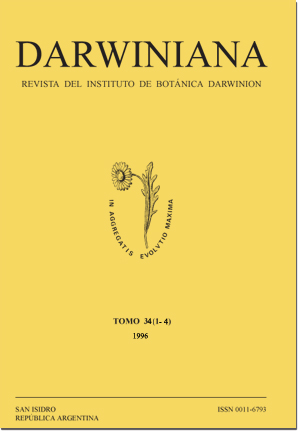Foliar anatomy of five patagonian species of Mulinum (Apiaceae).
DOI:
https://doi.org/10.14522/darwiniana.2014.341-4.385Abstract
The anatomy of the nomophylls of Mulinum microphyllum (Cav.) Pers., M. hallei Skottsb., M. valentinii Speg., M. echinus D. C. and M. leptacanthum Philippi has been studied. The five species share the following anatomical characters: amphistomatic leaves, one-layered epidermis, hypodermis, homogeneous mesophyll composed of palisade parenchyma, segments of the blade with sclerenchymatous strands in the central vein, vascular bundles accompanied by secretory canals, abaxial collenchyma strands under the main secretory canals, epidermis and mesophyll rich in crystals of calcium oxalate.
M. microphyllum and M. hallei differ from the other species by the following features: stomata frequently anisocytic, abaxial hypodermis, a midvein with a sheath interrupted by a sclerenchyma strand wich extends up to the adaxial epidermis. These two species show distinctive epidermal characteristics: papillae and other trichomes are only present in M. microphyllum. The other three species exhibit prevalence of anomocytic stomata, adaxial and abaxial hypoderrnis,midveins with a distinct sheath and a sclerenchyma strand within the sheath limit. M. echinus and M. valentinii have peristomatal rims, very compact mesophyll, few chloroplasts in hypodermal cells. However, both species differ from one another in epidermal features: papillae are only present in M. echinus; M. valentinii has adaxial epidermal outer cell walls thicker than the abaxial ones. On the other hand, in M. leptacanthum hypodermal cells are full of chloroplasts and epidermis without peristomatal rims.
The following xeromorphic characteristics have been detected in the five studied species: thick outer and inner periclinal walls of the epidermal cells, distinct outer stomatal rims, compact mesophyll with high developed palisade chlorenchyma, veins with sclerenchymatic supports. A dichotomic key based on foliar anatomy, to distinguish the studied species, is provided.
Downloads
Published
How to Cite
Issue
Section
License

Starting on 2012, Darwiniana Nueva Serie uses Licencia Creative Commons Atribución-NoComercial 2.5 Argentina .






